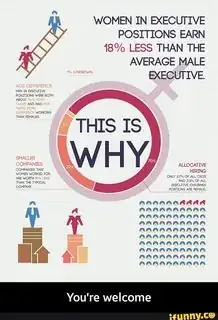Is this graph about female executives accurate?
Women in executive positions earn 18% less than the average male executive.
This is why:
- 70% Allocative hiring: only 3.7% of all CEOs and 2.3% of all executive chairmen positions are female.
- 22% Smaller companies: companies that women worked for are worth 10% less than the typical company.
- 7% Age difference: men in executive positions were both about five years older and had five years more experience working than females.
- 1% (Unknown)
You're welcome
ifunny.co
(Emphasis and snark copied from the original. Format adjusted for text.)
The claims seem to be
- Women earn 18% less than men on average, both in executive positions.
- Only 3.7% of CEOs are women.
- Only 2.3% of executive chairs are women.
- That companies for which female executives worked are worth 10% less than all companies. Bases unspecified (is a company with two female executives counted twice).
- That the average male executive is about five years older than the average female executive.
- And with five years more work experience.
- That the statistics about the age difference, company size, and allocative hiring explain 99% of the pay difference. Method unspecified--possibly linear regression.
